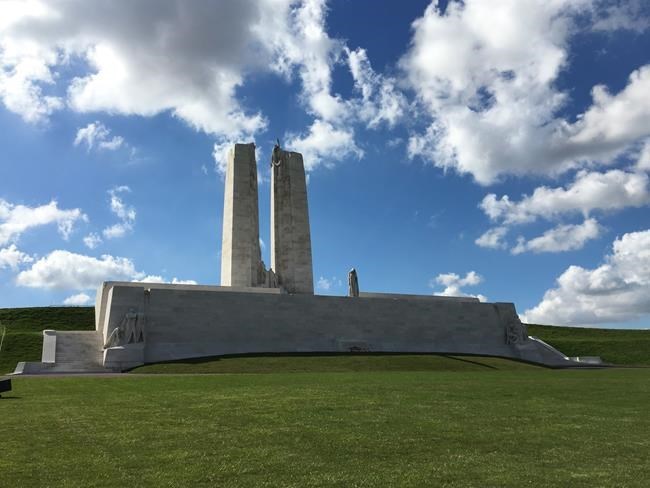
The Canadian National Vimy Memorial is seen in Northern France on September 22, 2017. The first thing you'll notice arriving at the grounds of the Canadian National Vimy Memorial in northern France is the ground itself. Although trees have sprung up in the century since the historic battle between the Canada Corps and the German army in the final year of the First World War, the ground is still covered with craters from the mortars, shells and other munitions that pounded the battlefield. THE CANADIAN PRESS/John Chidley-Hill
Republished November 10, 2017 - 7:34 AM
Original Publication Date November 10, 2017 - 5:01 AM
VIMY RIDGE, FRANCE, Canada - The first thing many notice when approaching the Canadian National Vimy Memorial in northern France is the ground itself.
Although trees have sprung up in the century since the historic battle between Canadian troops and the German army, the ground is still covered with craters from the mortars, shells and other munitions that pounded the battlefield.
The next thing that catches the eye is an official government sign welcoming visitors to Canada.
Located more than 10 kilometres north of the town of Arras, the government of France has ceded the 100-hectare battleground to Canada to serve as a museum and memorial. The site commemorates not just the Battle of Vimy Ridge, but the nearly 61,000 Canadians who lost their lives in the First World War.
A long driveway off Rue des Artilleurs Canadiens winds its way past gravel parking lots to a short, angular building that serves as the museum.
Admission is free to the site and the museum is staffed with Canadians working as tour guides, eager to answer questions or point out landmarks. A permanent exhibit explains how Canada was drawn into the war by its colonial ties to the United Kingdom and the resulting toll it took on the young nation. A detailed video map of the area illustrates the strategic importance of Vimy Ridge and how the Canadian victory helped turn the tide against Germany.
Particularly moving is a gallery of 3D renderings of carvings from deep inside the tunnels that honeycomb the ridge. These etchings were done by Canadian soldiers to pass the time as they waited to move into the forward trenches ahead of the opening charge on April 9, 1917.
Guides lead tours of the site in English and French, alternating every 30 minutes, highlighting parts of the trenches and underground tunnels that have been preserved. Visitors can walk through the cool, damp tunnels and lean against the walls that had been carved out of the chalk-rich soil. At its lowest point, the ceiling slopes down to five-foot-nine, underscoring the cramped conditions the soldiers endured. Moving through the tunnels, tourists emerge in a part of the forward lines and then walk through no man's land. There, the enemy lines were only 30 feet apart.
A path then leads to the impressive monument itself, perched on the lip of Vimy Ridge, towering over the Douai Plain. It is made of bright white limestone and engraved with the names of the more than 11,000 Canadian soldiers who were killed in France during the First World War and have no known grave. Alongside the monument sheep roam the field and keep the grass a manageable length since no lawnmower can navigate the thousands of craters.
At the base of the monument, where Canadians charged up the steepest part of the ridge to overrun German fortifications, visitors place photos, letters, crosses and poppies to honour the dead.
———
If you go:
The site is open daily from 9 a.m. to 5 p.m., except Mondays when it opens at 11 a.m. Admission to the museum and site are both free. It takes approximately two hours to see the museum, complete the tour of the trenches and visit the monument. Vimy Ridge is nearly 200 kilometres north of Paris and is about a two-hour drive from the French capital on toll roads.
Note to readers: This is a corrected story. A previous version stated that the Canadian National Vimy Memorial monument is inscribed with the names of all the Canadian soldiers killed during the First World War.
News from © The Canadian Press, 2017